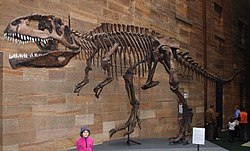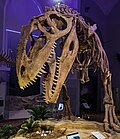Giganotosaurus
Giganotosaurus is a large theropod dinosaur. It lived during the Upper Cretaceous, about 99 - 97 million years ago in what is now Argentina. 70 percent of the skeleton has been found. Giganotosaurus was probably the second largest carnivorous dinosaur of all time. Another large carnivore, Mapusaurus, also lived in the same territory. They were both relatives of the North African Carcharodontosaurus.
| Giganotosaurus Temporal range: Upper Cretaceous 99 - 97 mya
| |
|---|---|

| |
| Replica of Giganotosaurus at the Australian Museum in Sydney. | |
| Scientific classification | |
| Kingdom: | |
| Class: | |
| Superorder: | |
| Order: | |
| Suborder: | |
| Family: | |
| Genus: | Giganotosaurus
|
The largest specimen is 14 m (46 ft) long,[1] and 4 m (13 ft) tall at the hip. Its weight is estimated as 13 t (29,000 lb).[2][3]
Titanosaur fossils belonging to Andesaurus and Limaysaurus have been found near the remains of Giganotosaurus. The huge titanosaur Argentinosaurus also lived in the area. Probably, the titanosaurs were the main prey of the large theropods.
Giganotosaurus Media
Full size model nicknamed "Lady Giga", Frankfurt Hauptbahnhof.
Size (green) compared to that of other large theropods
Reconstructed skeleton, Natural History Museum, Helsinki
Quadrate bone openings in various theropds; C (top) is Giganotosaurus
References
- ↑ Holtz, Thomas R. Jr. 2012. Dinosaurs: the most complete, up-to-date encyclopedia for dinosaur lovers of all ages. Winter 2011 Appendix.
- ↑ Seebacher, F. (2001). "A new method to calculate allometric length-mass relationships of dinosaurs". Journal of Vertebrate Paleontology. 21 (1): 51–60. doi:10.1671/0272-4634(2001)021[0051:ANMTCA]2.0.CO;2. ISSN 0272-4634. S2CID 53446536.
- ↑ Therrien F. and Henderson D.M. (2007). "My theropod is bigger than yours...or not: estimating body size from skull length in theropods". Journal of Vertebrate Paleontology. 27 (1): 108–115. doi:10.1671/0272-4634(2007)27[108:MTIBTY]2.0.CO;2. ISSN 0272-4634. S2CID 86025320.








